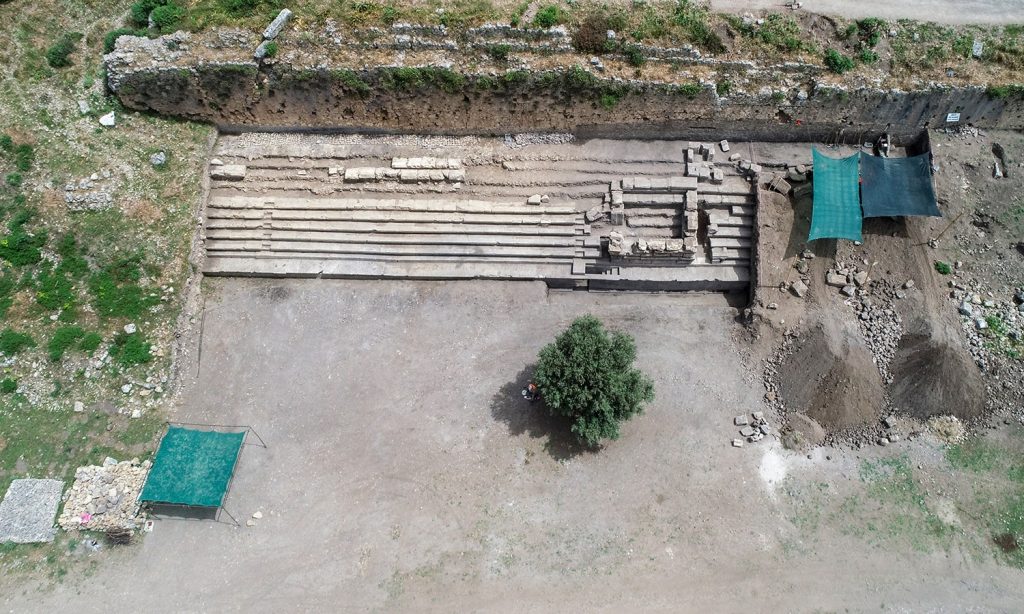
The massive stadium of Sillyon Ancient City is being uncovered
The 10 thousand-seat stadium of the ancient city of Sillyon in Antalya’s Serik district is being uncovered.
The excavation team has so far uncovered 25 percent of the stadium.
Sillyon excavations are carried out by a team of 40 people under the leadership of Pamukkale University Faculty Member Assoc. Prof. Dr. Murat Taşkıran.
Sillyon is an ancient city and fortress located on a hill between Aspendos and Perge in the Serik district of Antalya. The city dates back to the 2nd millennium BC and was home to many different civilizations such as Hittite, Persian, Roman, Byzantine and Ottoman.

One of the most important features of Sillyon is that it was built on a natural acropolis. In this way, the city had a natural protection without the need for walls. Walls, towers and trenches were built on the western and southwestern slopes of the city.
Stating that they concentrated their work on the Roman-era stadium, Taşkıran said that they uncovered 25 percent of the stadium under tons of soil, 254 meters long and 48 meters wide.
Taşkıran said, “In time, the land here was leveled, turned into a terrace and the stadium structure was placed here. The structure has a double tribune and also has a turning area.”

Taşkıran explained that sports competitions, competitions and festivals were held in the stadium in ancient times,
“Based on the materials recovered from the area, we can say that the construction of the stadium started in the 1st century after Christ and was used until the 5th century after Christ. This became clear in the excavations we carried out in the last phase. We have determined that there was an attack on Sillyon and that the stadium was destroyed during this attack. On the other hand, it is also possible to say that a canopy covered with a wooden construction was created on the eastern wing of the building.”
Pointing out that the ancient city is located at a point dominating the sea and the Taurus Mountains of the region, Taşkıran continued as follows:

“Sillyon is the only point that dominates the region from the sea or land even today. When you go to the top of Sillyon, you dominate all sea traffic from Side to Kemer. The stadium was built in a way that dominates this view. In other words, someone who wants to watch sports competitions can not only watch the competitions but also have a very nice time in a way that dominates the environment. From the stadium, we can see the ancient city of Perge, Kadriye-Belek tourism regions and the airport. This was also the case in ancient times. Because of this location, this place was probably designed as a fair-festival area. The main reason for the construction of a 10,000-seat stadium in a rugged hilly area is to watch the events and enjoy the view.”
You may also like
- A 1700-year-old statue of Pan unearthed during the excavations at Polyeuktos in İstanbul
- The granary was found in the ancient city of Sebaste, founded by the first Roman emperor Augustus
- Donalar Kale Kapı Rock Tomb or Donalar Rock Tomb
- Theater emerges as works continue in ancient city of Perinthos
- Urartian King Argishti’s bronze shield revealed the name of an unknown country
- The religious center of Lycia, the ancient city of Letoon
- Who were the Luwians?
- A new study brings a fresh perspective on the Anatolian origin of the Indo-European languages
- Perhaps the oldest thermal treatment center in the world, which has been in continuous use for 2000 years -Basilica Therma Roman Bath or King’s Daughter-
- The largest synagogue of the ancient world, located in the ancient city of Sardis, is being restored











Leave a Reply